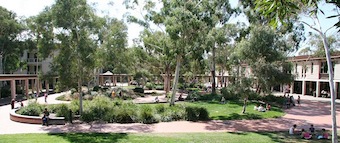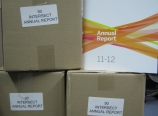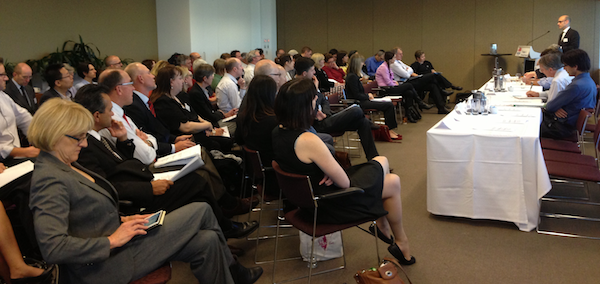Sharing Government Data Forum
Around 60 people attended the Sharing Government Data Forum last week, with large contingents from NSW Government agencies and the research sector – universities, CSIRO and NICTA. Headline speakers included Deirdre O’Donnell, NSW Information Commissioner, Stuart Coleman of the Open Data Institute, UK and Pia Waugh, Director Gov 2.0, Federal Department of Finance.
Government agencies outlined key data initiatives currently being developed, and researchers presented examples of government data being effectively used and analysed in environmental sciences, emergency services, building data, weather, housing and modeling Australia’s geothermal energy.
Key questions addressed were how to:
- identify and prioritise high value data sets of interest to research
- investigate value the research sector can bring to use of government data
- assist in data release and use initiatives, and
- identify mechanisms to enable closer research – government collaboration.
Intersect and the NSW Department of Trade and Investment jointly hosted the forum to identify how opening NSW Government data to university research can provide value to both researchers and NSW State agencies.
Intersect will continue to engage researchers to identify government data the research sector would like access. This will be provided to the Department of Finance and Services as they develop a pipeline of data release. Send any requests for data to researchdata@intersect.org.au
Sites of interest include: http://data.nsw.gov.au/, www.lpi.nsw.gov.au, http://www.services.nsw.gov.au/ict/
Proteomic-Genomic Nexus (AP11) wraps up
User Testing has been completed on the AP11 application.
Until this project there was a lack of tools with which to integrate data from the two fields of genomics and proteomics. This project aims to provide a ‘nexus’ for integrating genomics data generated from next-generation sequencing with proteomics data generated from protein mass spectrometry.
A set of tools has now been developed which allow users to:
- co-visualise genomic and proteomic data using the Integrated Genomics Viewer (IGV) using the SAM format
- analyse mass spectrometry results using customisable filters, which can be used to validate alternatively spliced isoforms of proteins.
- transcriptomics analysis for bacterial, archaeal, and viral genomes by generation of novel open reading frames for predicted genes from glimmer or from simple overlapping intervals in the later case, those simple intervals can be re-arranged to enable prediction of novel transcript sites
Downloads: the software is available via the GitHub code repository: https://github.com/IntersectAustralia/ap11_samifier
Project Blog: http://intersectaustralia.github.com/ap11/
The software is developed by Intersect in conjunction with the Systems Biology Initiative, School of Biotechnology and Biomolecular Sciences, UNSW.
This project is supported by the Australian National Data Service (ANDS). ANDS is supported by the Australian Government through the National Collaborative Research Infrastructure Strategy Program and the Education Investment Fund (EIF) Super Science Initiative.
Sydney Harbour Environmental Data Project DC2B
The vision of this project being run by the University of Sydney is to provide a continuous picture of harbour water properties for both public and professional use. With Internet access and assimilation of quality-controlled data, the modeled properties will provide reliable information about all of the harbour waterways and display quality information in near real time visualization.
The Sydney Estuary Hydrodynamic Model is an existing system installed at the Sydney Institute of Marine Sciences (SIMS) and real-time information about the harbour will be available at the website: www.sydneyharbourobservatory.org
Intersect is contributing to the overall SHED project by supplying developers who will build a system to visualise the data and enable access for researchers to the data. Their main effort will be in integrating existing software such as GeoServer, GeoNetwork, Sensor Web, 52 North SOS. Data generated will be served to Research Data Australia.
This project is supported by the Australian National Data Service (ANDS). ANDS is supported by the Australian Government through the National Collaborative Research Infrastructure Strategy Program and the Education Investment Fund (EIF) Super Science Initiative.
Research Data Storage: Status Update
The Intersect RDSI node is now accepting nominations of research data collections for storage on the node. For data to be eligible, it must be assessed as “valuable for future research” by Intersect’s Storage Allocation Committee. We encourage all researchers to nominate research data that is valuable for your future research – it need not currently be in your possession.
The application form can be found here.
The next Storage Allocation Committee meeting is May 27th.
eResearch analysts are working with member institutions to prepare applications to the committee. They are eager to assist you with your application, and to assist in all matters relating to research data storage.
Interested researchers can contact your local Intersect eResearch Analyst (http://www.intersect.org.au/key-contacts) for information.
We are hiring
We are currently recruiting for the following positions:
- Software Engineers/Developers – contract
- Storage Infrastructure Specialist
- Data Infrastructure Specialist
See http://www.intersect.org.au/job-opportunities
New staff
Gabriel Gasser Noblia joins us as a software engineer working on HCSvLab (Human Communication Science) project (http://www.intersect.org.au/HCSVlab) at Intersect.



